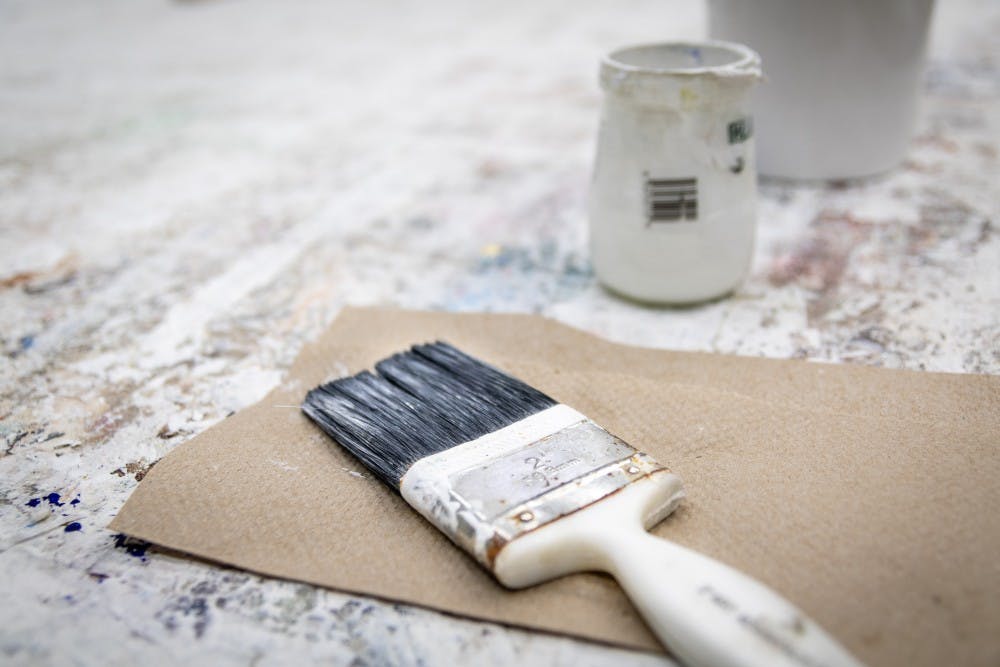The cost of being a student in the arts
College of the Arts and Media students discuss fees, expenses required for their majors
When Central Michigan University students begin their college career in the College of Arts and Media, they will find their tuition bill and books may not be the only expenses for the year.
The College of the Arts and Media includes programs such as music, art, photojournalism and broadcasting. Tuition per credit hour is $417, about $6,255 for 15 credits. Some classes may have additional fees to help pay for equipment, labs and materials. Each department handles the cost of its classes differently. The Office of Finance and Administrative Services provides a list of all approved fees.
The department also decides the best way to handle the cost of fees. Each department decides whether the costs should be paid for with department money, or if the funds should come from the students.
Art and Design Department Chair Jonathan Russell said art fees vary from class to class, and student to student. Introductory art classes usually have more size requirements on projects, which impacts the amount students spend on materials. Advanced classes let the students dictate the size of their projects, giving them more flexibility.
“You could have 10 people in one class, and depending on how big or how small they made their projects, they will pay a different amount based on materials,” Russell said.
Throughout Saginaw senior Ashley Medina’s career as an art major, she has spent $200 to $300 on supplies each semester. She said sculpting and painting classes usually add up quickly, whereas drawing classes tend to be less expensive. Although, a good set of drawing supplies could cost $100 or more. Classes like printmaking cost around $100 to use the chemicals.
The faculty members in the art department sometimes purchase materials such as paper, paints and clay, to make them easily available to students. If students want, they can pay for the paper or canvas per sheet or size. The faculty members do not do this for profit, they charge only what the materials are worth.
“For the most part, the only time I have fees through the art department is when I buy materials off the professors” Medina said. “They usually give us the best deals and a detailed syllabus with materials you will need.”
Music students also have to purchase extra equipment. Students pursuing the Bachelor's in Music Education with the instrumental options are required to take two semesters of marching band. Many students take it more than two years. String instrument majors (violin, viola, cello, bass) are exempt; they are welcome to be in marching band but not required.
Marching band members are required to purchase uniform accessories such as hats, gloves shoes, spats and a wind suit. Shoes cost $42, the track suit costs $85 and the Nylon gloves are $5 per pair. The total cost of the band gear is $271. Many students also pay $10 to rent a locker in the music building to store their equipment.
Instruments are loaned to students if they do not have their own. Music majors can check out instruments for free from the department, after signing a liability contract with the university.
Royal Oak junior Andrea Foerster is the piccolo section leader. She said all the band fees are charged to student accounts.
“We get into concerts for free and at the end of the Marching Band season we get a stipend” Foerster said.
The Broadcast and Cinematic Arts program has fees ranging from $10 to $60 for a class. Warren senior Joseph Pokorney said the fees depend on the class, because some have fees and others do not.
“All my professors notify me about the fees” said Pokorney. “I don’t mind the fees because it allows us to keep one of the best equipment cages in Michigan.”
Photojournalism majors also pay lab and equipment fees. According to the CMU’s official fee list, journalism 220, 320, 420 and 521 all have $25 fees. Photojournalism students are required to own a DSLR (digital single-lens reflex) camera before they can officially sign the major.
Journalism faculty member Kent Miller said students are aware of the fees and know where the money goes. The journalism department provides lenses worth more than $1,000, flashes, lighting kits and pop-up backgrounds. Miller says the money from fees pays for repairs, and the department covers most of the cost for the equipment that can be checked out.
“Equipment is probably the most expensive part. Although, renting the lenses from the department helps with cost” said Plymouth junior Ariana Strzalka.
Strzalka’s camera body cost about $1,000. She has a couple kit lenses that came wither her camera, which are cheaper than buying lenses individually. She also has a strobe light, a light stand, and a pocket wizard. Everything else she needs, she rents from the journalism department.
Strzalka said besides equipment, printing was the most expensive part of her photography classes. For an 8-by-11 inch sheet, printing costs $1.79. Bigger prints cost around $5 and posters cost $36.
Printing fees apply not only to photojournalism students, but also to graphic design students.
“There are a lot of printing fees when you are a graphic design major” said Farmington Hills senior Kyunna Huston. “But I can’t change how much it costs to print, or the fact the art materials are expensive.”




